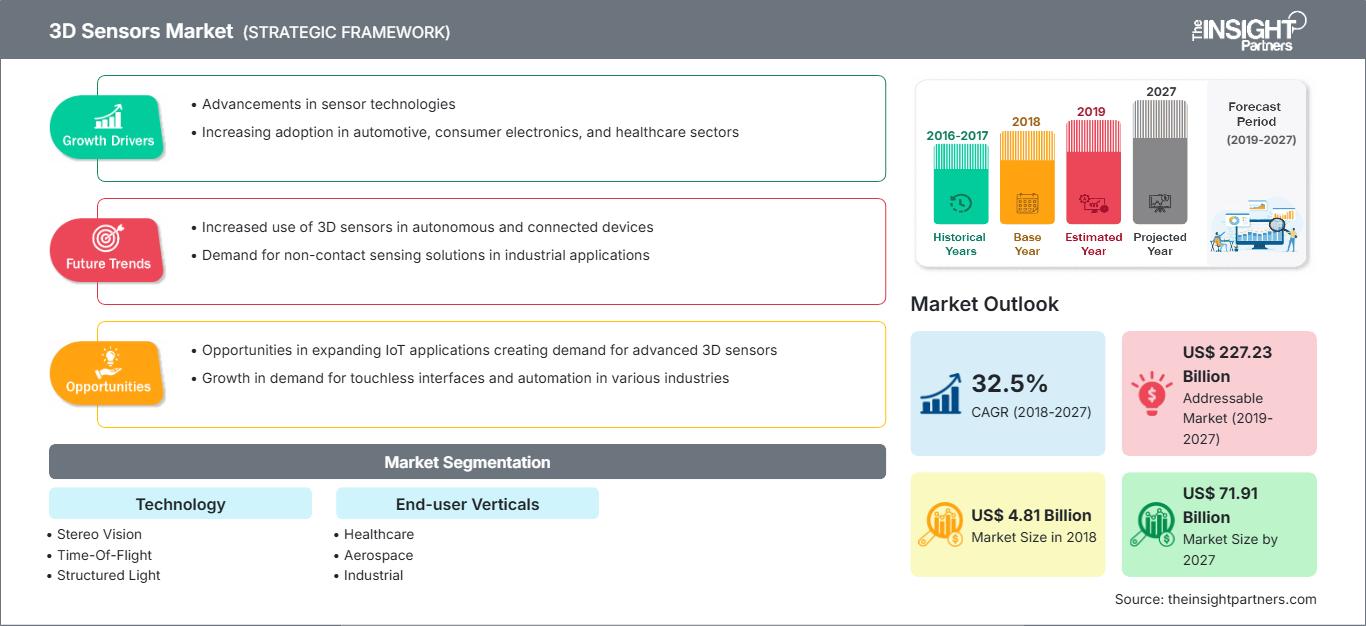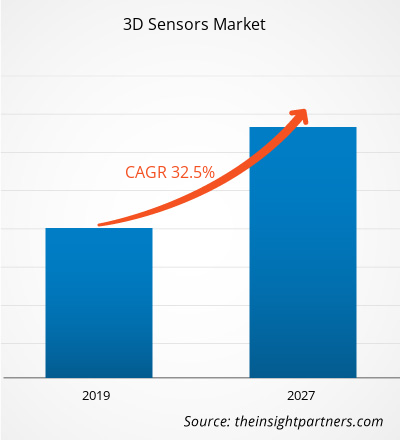[研究报告]2018 年 3D 传感器市场规模为 48.057 亿美元,预计到 2027 年将达到 719.142 亿美元;预计 2019 年至 2027 年期间的复合年增长率为 32.5%。
3D 传感器使用主动范围传感器,能够以高帧率提供深度图像。这些摄像头配备用于照亮视场的红外光源和用于捕捉反射红外光的 CMOS/CCD 传感器。深度测量基于 ToF 原理;因此,深度与红外信号到达物体或观察视场并返回所需的时间成正比。传感器每个像素获得的深度测量值共同构成深度图像。快速获取深度图像在机器人、人机交互和场景建模等众多终端用户垂直领域都具有重要意义。遗憾的是,目前许多可用的 ToF 相机分辨率较低,且容易受到各种测量误差的影响,包括传感器引起的噪声、由于难以生成正弦信号而产生的系统性摆动误差、依赖于反射率和积分时间的非线性深度偏移,以及信号在深度不均匀性(边缘)处叠加产生的飞像素。因此,ToF 传感器能够提供精准的深度测量。目前可用的多 ToF 传感器系统专注于通过依赖占用概率网格或配准从不同视图生成的点云等方式,将深度图像组合起来以构建 3D 重建。
ToF 技术已用于测距十多年。声纳 (SONAR) 和雷达 (RADAR) 是两种利用 ToF 原理的声音和无线电信号的技术,尤其在航空航天和航空终端用户垂直领域。近年来,随着电子设备的改进和成熟,ToF 系统已经能够采用光信号。使用此类系统的终端用户垂直行业众多,尤其是在工业和消费领域。现代 ToF 传感器通常采用两种测距技术:脉冲调制或连续波 (CW) 调制。先进的 ToF 系统采用多频技术,可组合更多调制频率。
自定义此报告以满足您的要求
您将免费获得任何报告的定制,包括本报告的部分内容,或国家级分析、Excel 数据包,以及为初创企业和大学提供超值优惠和折扣
3D传感器市场: 战略洞察

-
获取本报告的主要市场趋势。这个免费样本将包括数据分析,从市场趋势到估计和预测。
消费电子行业在发达国家和发展中国家都经历了巨大的增长,制造公司提供的进步和智能功能是这一增长的主要贡献者。
目前,个人使用各种消费电子设备来完成大量任务。智能手机、平板电脑、个人电脑、电视、洗衣机、冰箱和音乐播放器等消费电子产品已成为日常生活中不可或缺的一部分。随着技术的不断进步以及物联网 (IoT) 和人工智能 (AI) 的融合,所有这些设备都变得更加智能。传感器技术的进步为包括汽车领域在内的大多数技术领域的物联网和人工智能的显著增长铺平了道路。随着制造商不断在其设备中推出先进的技术和功能,以及发达经济体和发展中经济体用户可支配收入的不断提高,消费电子设备市场也在不断增长。
一些知名的智能手机制造商率先将 3D ToF 传感器集成到其智能手机型号中。华为、三星、Oppo、LG 和苹果等全球领先的智能手机制造商率先将 3D ToF 传感器集成到各种型号中。华为 P30 Pro、三星 Galaxy S10 5G、Oppo RX17 Pro、Honor View 20、LG G8 ThinQ 和 iPhone 2020 型号已经集成或计划集成 3D ToF 传感器到型号中。
最终用户垂直细分洞察
根据最终用户垂直领域,3D 传感器市场细分为医疗保健、航空航天、工业、汽车、消费电子等。曾经笨重的小玩意儿如今变得更加轻巧微型,配备了可以实时测量形状的传感器。技术的快速进步催生了大量新的应用。这些技术为汽车、国防、医疗保健、航空航天、机器人、电子消费品、半导体和零售等不同垂直行业带来了巨大的机遇,3D 传感器在这些行业中都有应用。各大公司正在建立合作伙伴关系,加大协作力度,以开发更多的 3D 应用。
技术细分洞察
根据技术,3D 传感器市场可分为立体视觉、飞行时间和结构光。3D 传感器在深度感知方面发挥着关键作用,能够连接现实世界中的设备。通过全面的研发,3D 传感器不断进步,激发了 3D 传感器市场的创造力。除了应用于汽车、医疗保健、机器人和国防领域外,3D 传感器还广泛应用于电视、智能手机和笔记本电脑等消费电子产品。除纳米技术外,3D 传感器还被应用于可穿戴设备。此外,智能手机制造商正尝试将 3D 传感技术融入游戏、人脸识别等领域。在医疗保健行业,3D 传感器有助于观察皮肤内层、肿瘤和静脉。在汽车行业,3D 传感器被广泛用于在发生碰撞或即将发生危险时发出警报,以避免事故发生。K 系列、iGPS、激光线扫描仪和激光雷达等产品都应用于航空航天和国防工业。随着电子、汽车和其他行业的创新发明不断涌现,3D传感器的应用将持续增长。
市场参与者专注于新产品的创新和开发,将先进的技术和功能融入产品中,从而与竞争对手展开竞争。
- 2019年:ams AG推出全新ASV技术产品组合,使消费电子、计算和工业产品制造商能够更轻松、更低成本地实现人脸识别和其他3D传感应用。凭借丰富的3D经验,ams已将主动立体视觉技术产品添加到产品组合中,以满足更多不同的3D传感应用需求,并在移动领域降低价格。此外,ams AG宣布与SmartSens Technology合作,通过此次合作,ams进一步扩展了其三种3D技术的产品组合,包括飞行时间(ToF)、主动立体视觉(ASV)和结构光(SL),并加快了新产品的上市时间。
3D 传感器市场区域洞察
The Insight Partners 的分析师已详尽阐述了预测期内影响 3D 传感器市场的区域趋势和因素。本节还讨论了北美、欧洲、亚太地区、中东和非洲以及南美和中美洲的 3D 传感器市场细分和地域分布。
3D传感器市场报告范围
| 报告属性 | 细节 |
|---|---|
| 市场规模 2018 | US$ 4.81 Billion |
| 市场规模 2027 | US$ 71.91 Billion |
| 全球复合年增长率 (2018 - 2027) | 32.5% |
| 历史数据 | 2016-2017 |
| 预测期 | 2019-2027 |
| 涵盖的领域 |
By 技术
|
| 覆盖地区和国家 |
北美
|
| 市场领导者和主要公司简介 |
|
3D 传感器市场参与者密度:了解其对业务动态的影响
3D 传感器市场正在快速增长,这得益于终端用户需求的不断增长,而这些需求又源于消费者偏好的不断变化、技术进步以及对产品优势的认知度不断提升等因素。随着需求的增长,企业正在扩展其产品线,不断创新以满足消费者需求,并抓住新兴趋势,从而进一步推动市场增长。

- 获取 3D传感器市场 主要参与者概述
- 立体视觉
- 飞行时间
- 结构光
全球 3D 传感器市场 - 按最终用户垂直行业
- 医疗保健
- 航空航天
- 工业
- 汽车
- 消费电子
- 其他
全球 3D 传感器市场 -按地理位置
-
北美洲
- 美国
- 加拿大
- 墨西哥
-
欧洲
- 德国
- 法国
- 意大利
- 英国
- 俄罗斯
- 欧洲其他地区
-
亚太地区 (APAC)
- 中国
- 澳大利亚
- 印度
- 日本
- 韩国
- 亚太其他地区
-
中东和非洲 (MEA)
- 沙特阿拉伯
- 南非
- 阿联酋
- 中东和非洲其他地区
-
南美洲
- 阿根廷
- 巴西
- 南美洲其他地区 (SAM)
公司简介
- AMS AG
- Infineon Technologies AG
- Ifm Electronic Gmbh
- Melexis
- Sony Corporation
- STMicroelectronics NV
- Basler AG
- Cognex Corporation
- OmniVision Technologies, Inc.
- LMI Technologies Inc.
- 历史分析(2 年)、基准年、预测(7 年)及复合年增长率
- PEST和SWOT分析
- 市场规模、价值/数量 - 全球、区域、国家
- 行业和竞争格局
- Excel 数据集
近期报告
相关报告
客户评价
购买理由
- 明智的决策
- 了解市场动态
- 竞争分析
- 客户洞察
- 市场预测
- 风险规避
- 战略规划
- 投资论证
- 识别新兴市场
- 优化营销策略
- 提升运营效率
- 顺应监管趋势






















 获取免费样品 - 3D传感器市场
获取免费样品 - 3D传感器市场